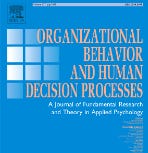New article in OBHDP (December 4th, 2024)
A Numeracy-Task Interaction Model of perceived differences
Daniel Villanova, Mario Pandelaere
https://www.sciencedirect.com/science/article/abs/pii/S0749597824000670
People often use numbers to compare options or evaluate alternatives. For example, imagine you are planning to purchase a new computer monitor and want to compare how two models are rated. After a short search, you find two websites that rate those monitors. On one rating site, the first monitor has a rating of 85 out of 100 and the other monitor has a rating of 65 out of 100. On the second rating site, the first monitor has a rating of 8.5 out of 10 and the other monitor has a rating of 6.5 out of 10. Although the relative difference (31%) between the ratings is identical on both sites, their absolute difference is much bigger on the first website (20 points) than on the second (2 points). This dynamic also occurs in the workplace. For example, a supervisor might tell an employee that “I’ve increased your vacation time from 2 weeks to 3 weeks” OR “I’ve increased your vacation time from 14 days to 21 days.” Although the vacation time increase (50%) is identical in both cases, the employee might perceive them differently. Indeed, some people are more sensitive to relative differences, whereas other people are more sensitive to absolute differences. However, research has not previously outlined who does what and in which cases. The authors propose the Numeracy-Task Interaction Model to provide a framework for understanding people’s subjective difference perceptions. With the help of four studies, the authors shed light on how “numeracy” (the ability to process basic probability and numerical concepts) relates to tendencies to weight absolute and relative differences, depending on the type of task. The authors find that numeracy can reduce the influence of absolute differences for some tasks but increase their influence for others. Additionally, sensitivity to relative differences increases for some tasks but not others.
P.S. if you can’t access the full-text let us (m-kouchaki@kellogg.northwestern.edu or mikebaer@asu.edu) know and we’d be happy to share a copy.


